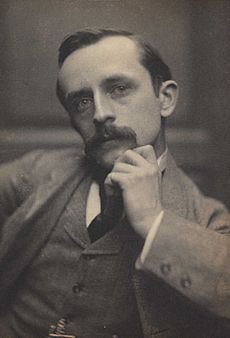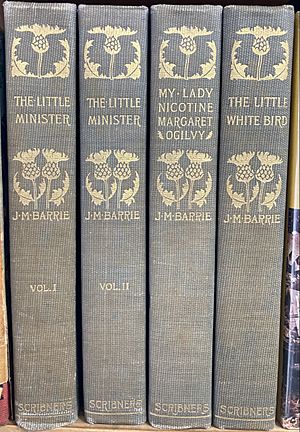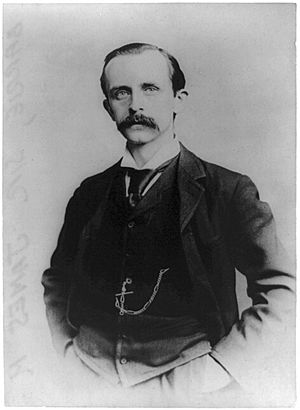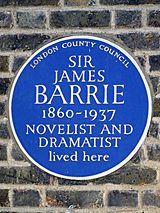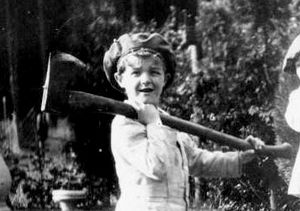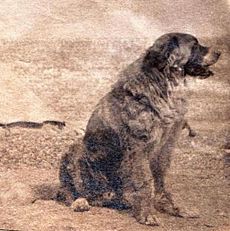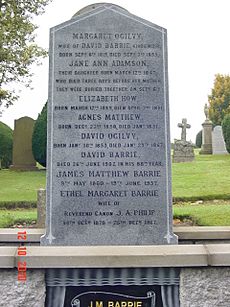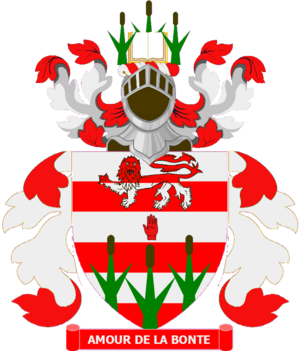J. M. Barrie facts for kids
Quick facts for kids
J. M. Barrie
|
|
|---|---|
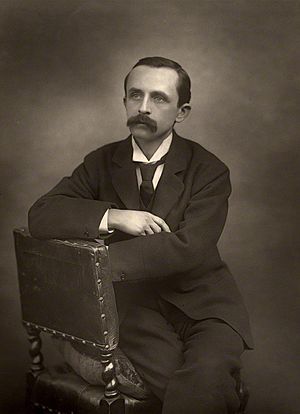
Barrie in 1892 by Herbert Rose Barraud
|
|
| Born | James Matthew Barrie 9 May 1860 Kirriemuir, Angus, Scotland |
| Died | 19 June 1937 (aged 77) London, England |
| Resting place | Kirriemuir Cemetery, Angus, Scotland |
| Occupation | Novelist, playwright |
| Education |
|
| Alma mater | University of Edinburgh |
| Period | Victorian, Edwardian |
| Genre | Children's literature, drama, fantasy |
| Notable works | |
| Spouse |
Mary Ansell
(m. 1894; div. 1909) |
| Children | Guardian of the Llewelyn Davies boys |
| Signature | |
 |
|
Sir James Matthew Barrie (born May 9, 1860 – died June 19, 1937) was a famous Scottish writer. He is best known for creating the beloved character Peter Pan. Barrie was born and grew up in Scotland. Later, he moved to London to write.
In London, he met the Llewelyn Davies boys. They inspired him to write stories about a magical boy. First, he wrote about a baby boy's adventures in Kensington Gardens. This story appeared in his 1902 novel, The Little White Bird. Then, he wrote Peter Pan, or The Boy Who Wouldn't Grow Up. This play opened in 1904. It tells the story of an ageless boy and a girl named Wendy who have adventures in Neverland.
Peter Pan became very popular. It even made the name Wendy famous. Barrie later became the guardian of the Davies boys after their parents passed away. King George V made him a baronet in 1913. He also became a member of the Order of Merit in 1922. Before he died, Barrie gave the rights to his Peter Pan works to Great Ormond Street Hospital for Children in London. This hospital still benefits from his generous gift today.
Contents
Growing Up in Scotland
James Matthew Barrie was born in Kirriemuir, Scotland. His family followed a strict religious group called Calvinism. His father, David Barrie, was a weaver. His mother, Margaret Ogilvy, took care of the house from a young age. James was the ninth of ten children. All of them were taught to read, write, and do arithmetic. He was a small child, only about 5 feet 3 inches tall. He loved to tell stories, which made him stand out.
When James was six, his older brother David died. David was his mother's favorite. He died in an ice-skating accident just before his 14th birthday. Barrie's mother was very sad. But she found comfort knowing her son would stay a boy forever. James and his mother would tell each other stories. They also read books like Robinson Crusoe and works by Walter Scott.
At age eight, Barrie went to the Glasgow Academy. He lived with his older siblings, Alexander and Mary Ann, who taught there. When he was 10, he came home and studied at the Forfar Academy. At 14, he moved again to Dumfries Academy. He was still under the care of Alexander and Mary Ann. He loved to read all kinds of books. He especially liked adventure stories and "penny dreadfuls."
In Dumfries, he and his friends played pirates in a garden. This garden was at a house called Moat Brae. This playtime later inspired parts of Peter Pan. They also started a drama club. There, Barrie wrote his very first play, Bandelero the Bandit.
Becoming a Writer and Playwright
Barrie always wanted to be an author. His family wanted him to choose a different job, like being a minister. But he found a way to compromise. He went to the University of Edinburgh to study literature. While there, he wrote reviews for a newspaper. He earned his master's degree in 1882.
After university, he worked as a journalist in Nottingham for a year and a half. Back in Kirriemuir, he sent stories to a London newspaper. He used his mother's tales about their hometown, which he called "Thrums." The editor liked his "Scotch thing" stories. So, Barrie wrote a whole series of them. These stories became his first novels. They included Auld Licht Idylls (1888) and A Window in Thrums (1890). These books made him a successful writer.
Barrie then started writing for the theatre. His play Ibsen's Ghost (1891) was a funny parody. It made fun of plays by Henrik Ibsen. A famous critic named William Archer enjoyed it. Barrie's third play, Walker, London (1892), led him to meet actress Mary Ansell. They married on July 9, 1894. Barrie often used Mary's first name for characters in his books.
In 1901 and 1902, Barrie had two big successes. Quality Street was about a woman pretending to be her niece. The Admirable Crichton was a play about social classes. It showed how an aristocratic family and their servants changed roles when shipwrecked. Many people praised this play.
The Creation of Peter Pan
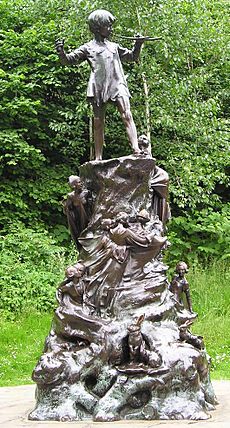
The character of Peter Pan first appeared in Barrie's novel The Little White Bird in 1902. His most famous work, Peter Pan, or The Boy Who Wouldn't Grow Up, was first performed as a play. It opened on December 27, 1904, in London. This play introduced the name Wendy to the world. It was inspired by a young girl who called Barrie "Friendy." She couldn't say her "R"s very well.
The play shows the everyday life of a middle-class family. This is contrasted with Neverland, a magical world. In Neverland, rules are different. The writer George Bernard Shaw said Peter Pan was "a play for grown-up people." He meant it had deeper meanings.
Barrie had many more successful plays after Peter Pan. Many of them talked about social issues. The Twelve Pound Look (1910) was about a wife gaining independence. Other plays, like Mary Rose (1920), explored ideas of ageless children. In 1911, Barrie turned the Peter Pan play into a novel called Peter and Wendy.
In 1929, Barrie gave the copyright of his Peter Pan works to Great Ormond Street Hospital. This is a children's hospital in London. His last play was The Boy David (1936). It was based on the Biblical story of King Saul and young David. Like Peter Pan, the role of David was played by a woman.
Barrie's Friends and Connections
Barrie had many famous friends. He knew other writers like Robert Louis Stevenson and George Bernard Shaw. H. G. Wells was also a friend for many years. Barrie stayed connected to his Scottish roots. He often visited his hometown of Kirriemuir with the boys he cared for.
After World War I, Barrie sometimes stayed at Stanway House. He even paid for the pavilion at their cricket ground. In 1887, he started an amateur cricket team. He called it the Allahakbarries. He thought this meant "Heaven help us" in Arabic. Many famous British authors played on this team. These included H. G. Wells, Rudyard Kipling, and Arthur Conan Doyle.
Barrie also became friends with famous explorers. These included Joseph Thomson and Robert Falcon Scott. Barrie was the godfather to Scott's son, Peter. Scott wrote a letter to Barrie in his final hours during his expedition to the South Pole. He asked Barrie to look after his wife and son. Barrie was so proud of this letter that he carried it with him always.
In 1896, Barrie met Broadway producer Charles Frohman. Frohman became his close friend and helped produce Peter Pan. Frohman famously refused a lifeboat seat when the ship RMS Lusitania sank. An actress who survived recalled Frohman saying, "Why fear death? It is the most beautiful adventure that life gives us." This was a line from Peter Pan.
In the 1930s, Barrie met the young daughters of the Duke of York. These were the future Queen Elizabeth II and Princess Margaret. Three-year-old Princess Margaret announced, "He is my greatest friend and I am his greatest friend."
Barrie's Marriage
Barrie met actress Mary Ansell in 1891. She helped care for him when he was very ill. They married in Kirriemuir on July 9, 1894. Mary then stopped acting. They did not have any children.
In 1895, the Barries bought a house in London. Barrie often walked in nearby Kensington Gardens. In 1900, they moved to a house overlooking the gardens. Mary was good at decorating. She made their home beautiful. They also bought a cottage in Surrey. Barrie used it to entertain his friends and the Llewelyn Davies family.
Barrie and Mary divorced in October 1909. Barrie continued to support Mary financially. He gave her money each year, even after she remarried.
The Llewelyn Davies Family and Peter Pan's Inspiration
The Llewelyn Davies family was very important to Barrie. The family included Arthur and Sylvia, and their five sons: George, Jack, Peter, Michael, and Nicholas.
Barrie met the family in 1897 in London's Kensington Gardens. He lived nearby and often walked his Saint Bernard dog, Porthos, there. He entertained the boys with stories and by wiggling his ears. He met their mother, Sylvia, later that year. She told him Peter was named after a character in her father's book.
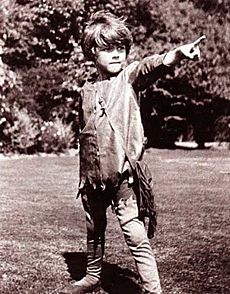
Barrie became a regular visitor to their home. In 1901, he invited the family to his cottage. There, he made a photo album of the boys playing pirates. He called it The Boy Castaways of Black Lake Island.
The idea for Peter Pan came from entertaining George and Jack. Barrie would tell them their little brother Peter could fly. He said babies were birds before they were born. Parents put bars on windows to keep them from flying away. This grew into the story of a baby boy who did fly away.
Arthur Llewelyn Davies died in 1907. Barrie, known as "Uncle Jim," became even more involved. He helped the family financially. After Sylvia died in 1910, Barrie became a guardian to the boys. He and their nurse, Mary Hodgson, cared for them until they grew up.
Barrie's relationships with the boys continued as they became adults. The Peter Pan statue in Kensington Gardens was put up in 1912. It was supposed to look like Michael dressed as Peter Pan. But the sculptor used a different child, which disappointed Barrie. He felt it didn't show Peter's mischievous side.
Barrie experienced sadness with the boys. He lost two of them when they were young men. George was killed in World War I in 1915. Michael, with whom Barrie wrote letters every day, drowned in 1921. He was almost 21 years old. Peter, another of the boys, later put together family letters and papers. He added his own thoughts about his family and Barrie. Peter died in 1960.
Barrie's Later Life and Legacy
J. M. Barrie died from pneumonia on June 19, 1937, in London. He was buried in Kirriemuir, Scotland, next to his parents. His birthplace is now a museum.
He left most of his money to his secretary, Lady Cynthia Asquith. But he had already given the rights to all his Peter Pan works to Great Ormond Street Hospital in London. This included The Little White Bird, Peter Pan in Kensington Gardens, the play Peter Pan, or The Boy Who Would Not Grow Up, and the novel Peter and Wendy. The surviving Llewelyn Davies boys also received money. He also made sure his former wife, Mary Ansell, would receive money each year.
Honours and Recognition
King George V made Barrie a baronet in 1913. He also became a member of the Order of Merit in 1922.
In 1919, he was chosen as the Rector of the University of St Andrews. He gave a famous speech there about courage in 1922. He also served as Chancellor of the University of Edinburgh from 1930 to 1937.
Barrie was the only person to receive the Freedom of Kirriemuir. This ceremony happened in 1930. He was given a silver box with the freedom scroll. The box showed places in Kirriemuir that were special to Barrie. These included his home and the Peter Pan statue.
Lasting Impact
Several schools are named after J. M. Barrie. These include the Sir James Barrie Primary School in London. The Barrie School in Maryland, USA, is also named in his honor.
|
See also
 In Spanish: James Matthew Barrie para niños
In Spanish: James Matthew Barrie para niños


